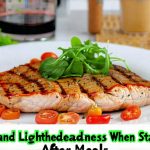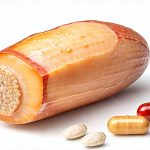Many people experience nausea at various points during the day—triggered not necessarily by illness, but by simple hunger. This isn’t always dramatic vomiting; it can manifest as a queasy stomach, lightheadedness, or even just a general feeling of unwellness that disrupts focus and productivity. Often, this type of hunger-induced nausea is preventable, and the key lies in understanding how your body reacts to dropping blood sugar levels and strategically using light snacks throughout the day to maintain stable energy. It’s about proactively managing your physiological response rather than reacting to discomfort after it begins.
The problem stems from a complex interplay between your digestive system, hormones, and brain. When you haven’t eaten for several hours, or if your previous meal wasn’t substantial enough, blood sugar levels begin to fall. This drop triggers the release of stress hormones like cortisol, which can irritate the stomach lining and contribute to feelings of nausea. Furthermore, an empty stomach produces more stomach acid, and without food to buffer it, this acid can cause discomfort and even trigger reflex vomiting in susceptible individuals. Understanding this cycle is the first step towards using snacks effectively as a preventative measure. It’s not about avoiding hunger entirely; it’s about mitigating its extreme dips that lead to nausea. You might also find information on managing symptoms during or after pregnancy with indigestion and nausea helpful.
The Science of Snack Timing & Composition
The effectiveness of snacking isn’t simply about what you eat, but also when and how often. A consistent pattern of small, frequent snacks is far more effective than relying on three large meals a day for many people prone to hunger-triggered nausea. This approach helps maintain stable blood sugar levels, minimizing the hormonal surges that contribute to discomfort. Think of it as smoothing out the peaks and valleys of your energy throughout the day – preventing those sharp drops that initiate the nauseous response. Consistent snacking is often more beneficial than large meals. If you’re looking for ideas on what to eat, check out food and drink choices that can help.
The composition of your snacks is equally crucial. Complex carbohydrates combined with a small amount of protein and healthy fats offer sustained energy release, preventing rapid blood sugar spikes and subsequent crashes. Avoid sugary snacks or refined carbs that provide a quick burst of energy followed by a steep decline. These can actually worsen the problem in the long run. Instead, focus on foods that are easy to digest and gentle on the stomach. For instance, a handful of almonds with a small piece of fruit provides both protein and complex carbohydrates for sustained energy, while being unlikely to cause digestive upset.
Finally, consider your individual tolerance. What works for one person may not work for another. Pay attention to how different foods affect your body and adjust your snacking strategy accordingly. Keeping a food diary can be incredibly helpful in identifying trigger foods or patterns that contribute to nausea. It’s about personalized prevention. If you experience random bouts of nausea, learning what to do can be very helpful.
Building Your Snack Arsenal
Choosing the right snacks is paramount, but it’s also important to have readily available options so you aren’t caught off guard by hunger and forced to choose less desirable alternatives. Here are some excellent choices categorized for different needs:
- For quick energy: A small banana, a handful of grapes, or a rice cake with a thin spread of peanut butter. These provide easily digestible carbohydrates for a fast but relatively stable boost.
- For sustained energy: Greek yogurt (plain, unsweetened) with berries, a small apple slice with almond butter, or whole-grain crackers with hummus. The protein and healthy fats slow down digestion, providing longer-lasting energy.
- For soothing the stomach: Ginger snaps, plain toast, or a few sips of chamomile tea. Ginger is known for its anti-nausea properties, while toast can help absorb excess stomach acid.
It’s also important to prepare snacks in advance and keep them accessible at work, in your car, or wherever you spend most of your day. This eliminates the temptation to skip snacking due to convenience or lack of options. Preparation is key to consistent preventative care. Sometimes a simple snack can prevent morning nausea.
Hydration’s Role in Nausea Prevention
Often overlooked, adequate hydration plays a significant role in preventing hunger-triggered nausea. Dehydration can exacerbate feelings of weakness and dizziness that often accompany low blood sugar, intensifying the nauseous sensation. Water helps regulate body temperature, aids digestion, and keeps your system functioning optimally.
- Aim to sip water throughout the day rather than chugging large amounts at once.
- Consider incorporating hydrating foods into your snack choices, such as fruits (watermelon, oranges) or vegetables (cucumber, celery).
- Avoid sugary drinks, which can cause rapid blood sugar spikes and crashes, ultimately worsening nausea.
- Herbal teas like ginger or peppermint tea can also be incredibly soothing for the stomach.
Staying well-hydrated is a simple but powerful tool in preventing nausea. It doesn’t replace strategic snacking, but it complements it beautifully. You may also benefit from electrolyte drinks if dehydration is playing a role.
Listening to Your Body’s Signals
Ultimately, the most effective approach to preventing hunger-triggered nausea is to become attuned to your body’s individual signals. Pay attention to those early warning signs of hunger—a slight dip in energy, a rumbling stomach, or even just a feeling of mild irritability—and respond with a small snack before the nausea begins. Don’t wait until you feel actively sick; prevention is far easier than treatment.
- Experiment with different snacking strategies and food choices to find what works best for you.
- Keep a food diary to identify potential trigger foods or patterns.
- Be mindful of your activity level, as increased physical exertion may require more frequent snacks.
- Don’t feel guilty about snacking; it’s not a sign of weakness, but rather a proactive step towards maintaining your well-being and preventing discomfort. Prioritize self-awareness and responsiveness. If you find yourself battling nausea during cold and flu season, these tips are still relevant!
It is important to remember that this information is for general knowledge and informational purposes only, and does not constitute medical advice. It is essential to consult with a qualified healthcare professional for any health concerns or before making any decisions related to your health or treatment.


















